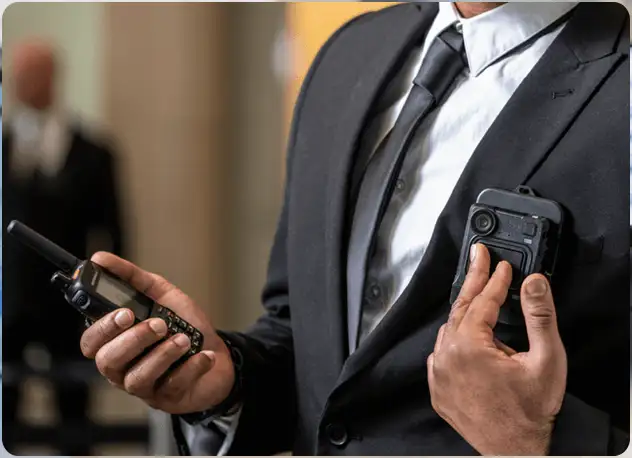Body-worn cameras (BWCs) have become one of the most visible tools in public safety and security today. Support for their use is overwhelmingly high. In fact, surveys show that nearly nine in ten Americans (89%) favor requiring police officers to wear cameras that record their on-duty interactions. Adoption continues to expand across the country as well. The most recent data available suggests that 47% of general-purpose law enforcement agencies had acquired BWCs, with that number rising to 80% among large police departments. Given the pace of adoption and the growing demand for transparency, it’s safe to assume that these percentages are even higher today.
Yet while the devices themselves are widely accepted, the policies that govern how video footage is stored, accessed, and shared remain complex. Agencies and enterprises face difficult questions: How do you promote transparency without compromising privacy? How do you balance employee rights with the public’s right to know? And how do you remain compliant with Freedom of Information Act (FOIA) requests, state disclosure laws, and evolving privacy regulations?
This article explores the best practices for shaping a comprehensive body-worn camera policy, with a focus on three critical areas: redaction, retention, and review. By developing clear, consistent policies in these areas, agencies can protect themselves legally, maintain public trust, and safeguard the rights of their employees.
Why a Strong Body-Worn Camera Policy Matters
You can probably make your own assumptions as to why having a body-worn camera policy in place matters. Without a policy that members of law enforcement need to adhere to, it can be up to individual preferences as to when, where, and even how these body cameras are used. That kind of inconsistency not only weakens accountability but also stands in the way of the ultimate goal: providing a reliable, transparent record of interactions.
A well-defined body-worn camera policy is the foundation for building public trust. Communities expect transparency, and when they know that cameras are used consistently and fairly, confidence in law enforcement and security operations grows.
Policy also makes sure that agencies can meet Freedom of Information Act (FOIA) requests and state-level public records requirements. Without clear rules around data access and disclosure, agencies risk delays, errors, or even accusations of withholding evidence.
At the same time, policy protects employees. Body-worn camera footage can intersect with workplace rights, union agreements, and disciplinary reviews. By setting guidelines for when footage can be accessed and how it can be used, agencies create safeguards that respect both accountability and employee privacy.
Finally, a consistent policy reduces exposure to litigation and regulatory fines. Courts and oversight bodies are quick to call out inconsistent or incomplete practices, which can undermine cases or lead to penalties. A clear, enforceable policy not only strengthens compliance but also provides a legal shield for the agency itself.
Core Elements of a Body-Worn Camera Policy
Creating a strong body-worn camera policy requires more than deciding when officers should hit “record.” It must be comprehensive, detailed, and enforceable. According to best practice guidance, policies should clearly cover the following core areas:
- Recording Protocols: Define when cameras must be activated—such as during calls for service, traffic stops, arrests, or any adversarial encounter. Include exceptions for unsafe, impossible, or impractical situations, and require officers to document any missed recordings.
- Download and Storage Procedures: Assign responsibility for downloading data (typically the officer, except in serious incidents where a supervisor should take custody). Policies should also mandate end-of-shift downloads, tamper-prevention safeguards, and accurate categorization of footage as evidentiary or non-evidentiary.
- Retention Schedules: Specify retention periods for both evidentiary and non-evidentiary footage, ensuring compliance with state law and balancing transparency with storage capacity. Agencies should make retention timelines public to support accountability.
- Data Storage Standards: Clarify where video will be stored (in-house servers, cloud databases, or hybrid models). Policies should address security, chain-of-custody, reliable backup methods, and audit trails, particularly if using third-party vendors.
- Access and Review Rules: Define who can access footage and under what circumstances. Officers should generally be permitted to review footage before making statements, while supervisors may review recordings in cases of complaints, training needs, probationary evaluations, or patterns of misconduct.
- Training Requirements: Mandate comprehensive training before deployment and annual refreshers. Training should cover state laws, proper use of equipment, downloading/tagging, evidence preparation, malfunction reporting, and scenario-based exercises.
- Policy Evaluation and Updates: Require periodic reviews that consider recording practices, storage and disclosure policies, training programs, community feedback, officer feedback, and audit findings.
A well-crafted policy sets the tone for transparency, accountability, and legal compliance across the entire agency.
Data Access & Privacy: Setting Boundaries
Body-worn cameras capture highly sensitive information, not just about suspects, but also about bystanders, officers, and witnesses. That’s why strong boundaries around access and privacy are non-negotiable. Federal guidance highlights how body-worn camera programs must safeguard personally identifiable information (PII) such as names, addresses, medical details, and even incidental images of private citizens
Without these guardrails, agencies risk exposing sensitive data, undermining investigations, or eroding community trust.
Motorola’s SVX Body-Worn Camera System helps agencies set clear access controls right in the field. Unlike platforms that require computer-based tagging, the SVX allows officers to categorize footage immediately, reducing errors and tightening the chain of custody. Other systems also have built recognition for integrated event activation and FedRAMP-certified data management.
Both approaches reflect an industry-wide recognition that controlling who can view, share, or redact footage is central to accountability.
For agencies, the privacy stakes are high:
- Protecting bystander and officer privacy through redaction protocols and access control lists
- Meeting FOIA and state-level public records obligations while safeguarding sensitive material
- Preserving data integrity with encryption and audit trails
- Preventing unauthorized access through secure sign-on and case-level permissions
In short, clear boundaries on access and privacy don’t just keep agencies compliant—they protect employees, reassure communities, and uphold the legitimacy of the footage itself.

Redaction Best Practices
A good body-worn camera policy must include robust, legally defensible redaction practices. The U.S. Department of Justice’s Best Practices for Video Redaction offers helpful direction.
What must be redacted?
- Faces, especially of bystanders, victims, minors, and witnesses.
- License plates, addresses, personal identifying details.
- Sensitive information, including medical data, privileged communications, or incidents inside private residences.
Automated Redaction vs. Manual Review
There are trade-offs. Automated tools (e.g. for blurring faces or plates) speed up processing, but may miss edge cases. Manual review catches more nuance but is time-intensive, especially frame-by-frame.
Here are some tips on how to build a redaction workflow.
- Request intake: Define how FOIA or public record requests are submitted.
- Review: Designate who reviews footage, what tools are used, what standard of redaction is required.
- Approval: Establish who signs off before releasing footage (legal / FOIA officer/supervisor).
Make sure staff responsible for redaction are well trained: how to use the tools, how to interpret privacy laws, how to spot sensitive content. Consistency matters for legal defensibility.
Also, under FOIA guidance, agencies must communicate with requesters early about realistic redaction timelines. Setting expectations, possibly narrowing the request’s scope, can help avoid delays. Courts expect that video redaction is doable and not overly burdensome.
How Long Should Footage Be Kept?
Retention timelines are one of the most important elements of a body-worn camera policy. In Florida, Statute Section 119.071(2)(l)5 requires law enforcement agencies to keep body-camera recordings for at least 90 days. After that point, retention depends on whether the footage becomes part of an official investigation. Agencies have the authority to create internal policies that extend retention beyond the 90-day minimum, based on the circumstances of an incident.
Recordings linked to serious events are typically retained much longer, including:
- Use-of-force incidents
- Officer-involved shootings
- Complaints filed against an officer
- Criminal investigations
By aligning policy with both statutory requirements and operational needs, agencies prioritize compliance while maintaining accountability.
Prioritizing Accountability
A body-worn camera policy is only as strong as its oversight. Agencies that prioritize accountability create systems to regularly review, audit, and apply lessons from footage. This not only protects officers and communities but also reinforces public trust. Key practices include:
- Supervisory reviews: Supervisors should periodically review recordings to confirm policy compliance and address concerns early.
- Incident-driven reviews: Footage tied to use-of-force events, citizen complaints, or critical incidents should be flagged and examined in detail.
- Random audits: Scheduled audits help confirm that retention schedules are being followed and that footage is properly categorized.
- Training opportunities: Reviewing footage for instructional purposes allows agencies to highlight effective practices and correct problematic behaviors.
- Documentation: Every review or audit should be logged, creating a defensible trail that shows consistent oversight.
Best Practices for Drafting & Updating Your Body-Worn Camera Policy
A body-worn camera policy should never be static. As laws evolve, technology advances, and community expectations shift, agencies must revisit and refine their approach. A few best practices stand out:
- Involve stakeholders: Bring in command staff, legal advisors, IT teams, union representatives, and even community leaders during the drafting process. Diverse input creates a stronger, more balanced policy.
- Pilot programs: Test workflows before a full rollout. Pilot groups allow agencies to evaluate activation protocols, tagging processes, and review procedures in real-world conditions, uncovering issues early.
- Regular policy reviews: Schedule periodic reviews to prioritize and confirm compliance with new state or federal legislation and to adopt emerging technologies such as automated redaction or cloud-based storage.
- Training and communication: Policies only work if people understand them. Provide comprehensive training and consistent communication so every employee knows their role in upholding accountability and transparency.
EMCI Wireless is a Reseller for Motorola Body Worn Cameras
A clear, well-structured body-worn camera policy is non-negotiable for protecting transparency, privacy, and accountability. By defining standards for redaction, retention, and review, agencies safeguard themselves from legal and reputational risks while demonstrating their commitment to responsible policing. These practices not only help meet compliance requirements. They also highlight the broader benefits of body-worn cameras in strengthening trust between agencies, employees, and the communities they serve.
When approached thoughtfully, policy becomes more than a set of rules; it becomes the foundation for stronger relationships, clearer communication, and more consistent accountability.
At EMCI Wireless, we partner with agencies to deliver Motorola’s secure, reliable, and easy-to-use body-worn camera solutions. If your agency is ready to refine or expand its BWC program, reach out to EMCI Wireless to explore technology and support that help turn strong policy into everyday practice.

